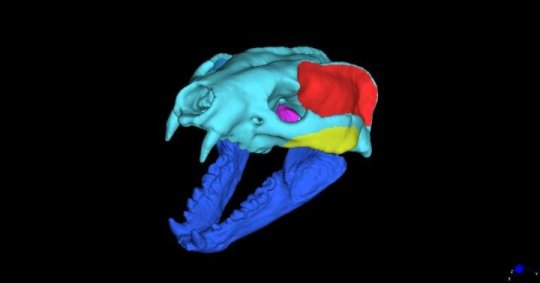[ad_1]
New research on an extinct weasel relative reveals what it might have eaten when it lived in North America and Asia about 20 million years ago. The oddly shaped skull of Leptarctus primus has long led to conflicting theories about its diet. But the new work, based on biomechanical modeling and published this week in the Journal of Vertebrate Paleontology, shows that Leptarctus was likely a carnivorous predator, with capability for omnivory and a broader diet when prey was scarce, and had a skull that functioned similarly to that of the living American badger.
Leptarctus primus, which lived in the Miocene and was just a little larger than a housecat, has intrigued researchers because of its unusual and extremely robust skull.
“For a mammal, its skull is really strange,” said co-author Z. Jack Tseng, a research associate at the American Museum of Natural History and an assistant professor of pathology and anatomical sciences at the Jacobs School of Medicine and Biomedical Science at the University at Buffalo. “It’s heavily built — like a tank — with very thick zygomatic cheek bones. The top of its head looks like it’s wearing a helmet.”
Strikingly, Leptarctus primus has two parallel ridges that line the top of the head (other carnivorans typically have a single central ridge or have smooth skulls). For many years, paleontologists have debated the ecological niche of Leptarctus based on conflicting interpretations of the strong parallel skull ridges, distinctive skull shape, and the shape of its teeth and chewing wear. Previous interpretations of their feeding lifestyle ranged widely, across virtually every type of known feeding behavior in carnivorans (dogs, cats, hyaenas, bears, seals, and weasels and their relatives), including herbivore, carnivore, insectivore, and omnivore. But because of the lack of quantitative research into how Leptarctus skulls functioned, the question of their diets remained unanswered.
In this study, led by Alixandra Prybyla, who was a student in the Museum’s National Science Foundation Summer Research Experience for Undergraduates program while at Columbia University, the researchers took an engineering approach. The team compared an almost complete fossil skull of Leptarctus primus with 18 species of modern carnivorans with known diets as well as to other fossil species, using bite simulations based on CT scans of the skulls and virtual modeling of feeding mechanics.
According to John Flynn, study co-author, research team leader, and Frick curator of fossil mammals in the Museum’s Division of Paleontology, “Traditional methods of studying skull, tooth, and skeleton anatomy are still essential for understanding how fossil species lived. But high-resolution x-ray CT images and sophisticated computerized engineering modeling tools have completely transformed our ability to accurately reconstruct feeding habits in extinct animals.”
They found that among the other species analyzed, the skull of Leptarctus is mechanically most similar to the skull of the American badger. Despite some differences in their skull appearances, the computer simulations indicate that the badger is the best living biomechanical analog for understanding the dietary lifestyle of Leptarctus. Based upon those comparisons, the team determined that it was primarily a carnivore and an active predator, but that it could also have been an omnivore feeding on a wider range of plant and insect foods when necessary.
“It was probably hunting down prey and taking in whatever it had access to most of the time,” Tseng said.
Prybyla added: “This complete skull of Leptarctus represents an untapped wellspring of information on the history of ancient relatives of weasels, otters, badgers, and skunks. It’s wonderful what one specimen can illuminate for researchers. To spearhead a project of this magnitude as an undergraduate student was extremely empowering.”
The researchers will conduct future studies using similar engineering modeling tools to look at variations in skull feeding mechanics among other species in the leptarctine group, to determine how many different types of feeding adaptations may have existed among these unusual extinct predators.
Story Source:
Materials provided by American Museum of Natural History. Note: Content may be edited for style and length.
[ad_2]















